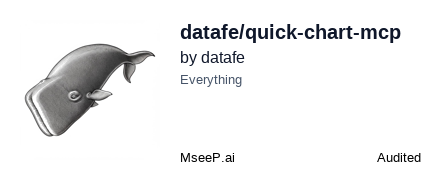About
A Model Context Protocol server that provides tools to interact with Quick Chart, enabling AI agents to generate and retrieve chart images via a standardized interface.
Capabilities

Quick Chart MCP Server – Overview
Quick Chart MCP is a lightweight, Model Context Protocol server that exposes the functionality of the open‑source Quick Chart library through a standardized tool interface. By wrapping Quick Chart’s chart generation capabilities in MCP tools, the server allows AI assistants such as Claude to create, modify, and retrieve chart images without needing direct access to the underlying codebase. This abstraction simplifies integration for developers who want to embed dynamic visualizations into conversational agents, dashboards, or data‑driven applications.
The server solves a common pain point for AI developers: the difficulty of generating charts on demand while maintaining consistency, security, and ease of use. Traditional charting libraries require manual setup, API key management, or embedding within a web stack—tasks that can distract from the core logic of an AI workflow. Quick Chart MCP removes these hurdles by providing two primary tools— and . The former accepts chart parameters (e.g., type, data, styling options) and returns a direct URL to the rendered image. The latter automates the local installation of Quick Chart, ensuring that the service is available on the host machine without manual intervention.
Key capabilities include:
- Standardized Tool Interface: Each tool follows MCP’s specification, enabling seamless discovery and invocation by any compliant AI client.
- Secure Configuration: Environment variables control sensitive settings such as the Quick Chart draw URL and installation flags, allowing secure operation in production environments.
- Timeout & Auto‑Approve Controls: Clients can configure how long the server waits for a response and whether certain actions require manual approval, giving developers fine‑grained control over execution flow.
- Cross‑Platform Compatibility: Built on Node.js, the server runs on Windows, macOS, and Linux, making it versatile for diverse deployment scenarios.
Real‑world use cases are abundant. A data analyst chatbot can ask a user for preferences, then generate a bar chart or line graph and present the image link directly in the conversation. A marketing assistant can produce quick visual summaries of campaign metrics on demand, while a developer tooling agent can automatically install Quick Chart during CI pipelines. In educational settings, tutors can illustrate concepts with dynamically generated diagrams without leaving the chat interface.
Integration into AI workflows is straightforward. Once registered, an MCP client simply sends a JSON payload describing the desired chart (type, data points, colors). The server processes the request, leverages Quick Chart’s rendering engine, and returns a URL that the client can embed in messages or dashboards. Because the server adheres to MCP’s transport and command conventions, it plugs into existing toolchains such as Claude Desktop, Cursor, or any custom agent built on the MCP ecosystem.
Unique advantages of Quick Chart MCP include its zero‑dependency deployment model (no Docker or cloud services required) and its focus on image link generation rather than raw SVG, which simplifies caching and rendering in client applications. By abstracting the complexity of chart creation behind a clean, protocol‑driven interface, Quick Chart MCP empowers developers to enrich AI experiences with rich visual data effortlessly.
Related Servers
n8n
Self‑hosted, code‑first workflow automation platform
FastMCP
TypeScript framework for rapid MCP server development
Activepieces
Open-source AI automation platform for building and deploying extensible workflows
MaxKB
Enterprise‑grade AI agent platform with RAG and workflow orchestration.
Filestash
Web‑based file manager for any storage backend
MCP for Beginners
Learn Model Context Protocol with hands‑on examples
Weekly Views
Server Health
Information
Tags
Explore More Servers
Python MCP Demo Server
FastAPI-powered MCP server for quick prototyping
Playlist MCP Server
Generate mood‑based playlists directly on your PC
Iaptic MCP Server
Connect AI to Iaptic data effortlessly
BGG MCP: BoardGameGeek MCP Server
Access BoardGameGeek data via Model Context Protocol
Alchemy MCP Server
Bridge AI agents to blockchain data and actions
Mcp Server Again
Re-implementing MCP server functionality in Python